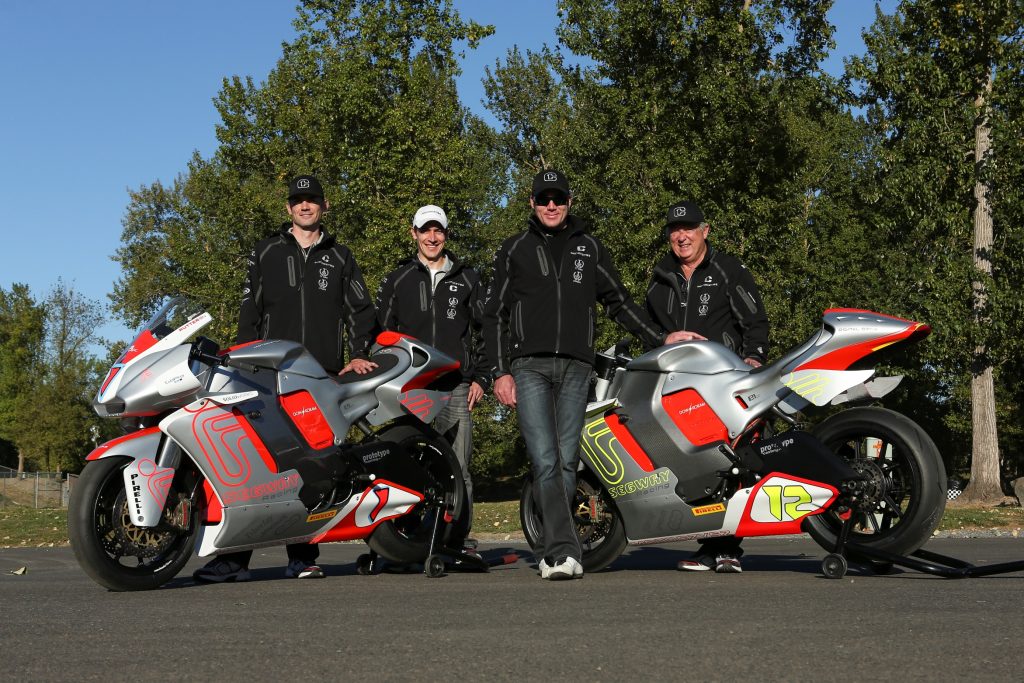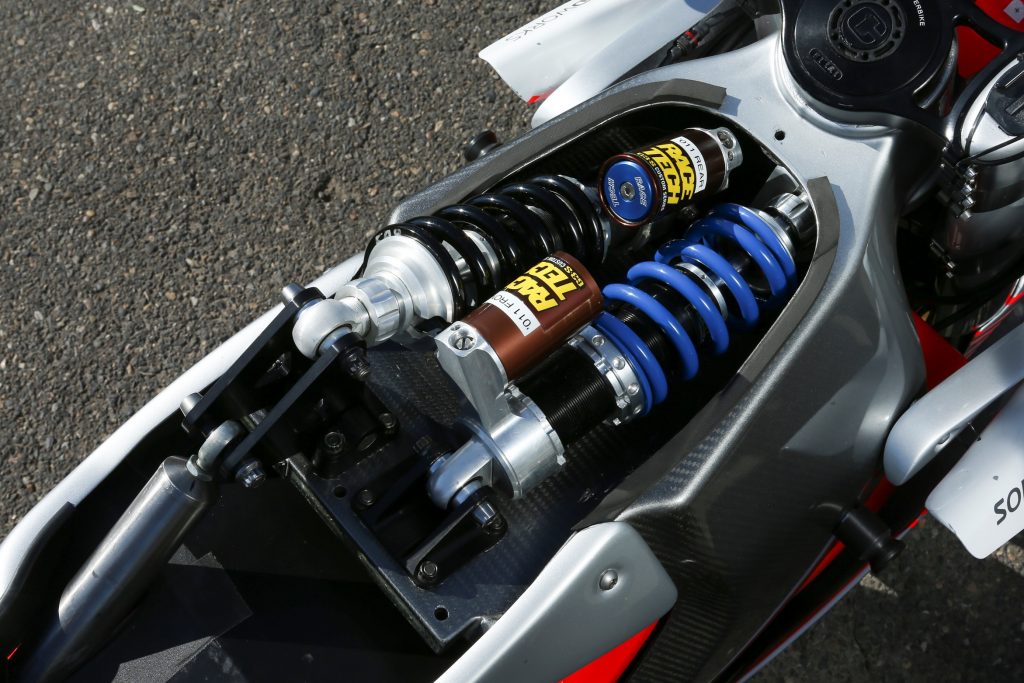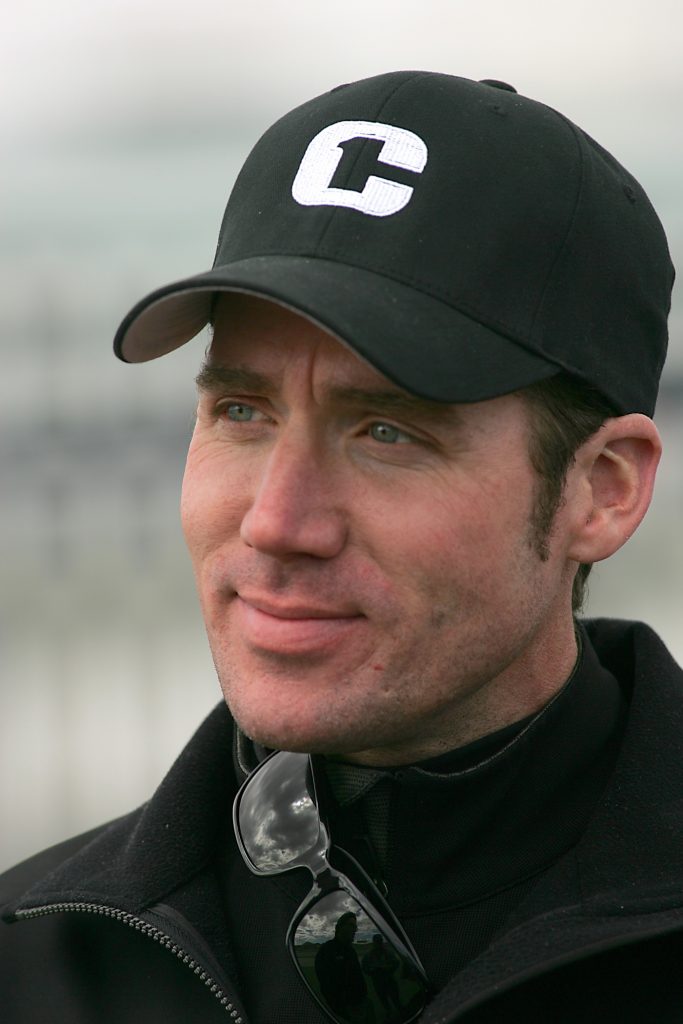American motorcycle design visionary Michael Czysz passed away aged 52 on 7 May at his Portland, Oregon home, after a long fight with a rare and aggressive form of cancer. He was an innovative two-wheeled free-thinker whose creations ultimately enjoyed serial success in the Isle of Man TT. Yet in a decade of thinking outside the box in terms of design, Czysz confronted two completely different engineering challenges: firstly, a prototype MotoGP racer done differently, then what are widely regarded as the most successful electric road racers yet built.
In a previous life before motorcycles, Michael Czysz (pronounced ‘sizz’, as in sizzle) acquired fame and fortune during a 20-year career as one of America’s top architects through his Architropolis design firm, designing Las Vegas hotels and nightclubs, and creating multi-million dollar homes for A-list celebrities like Cindy Crawford and Lenny Kravitz. But Michael had a family heritage on two wheels, too. Grandad Clarence Czysz was a top Manx Norton tuner in AMA competition in the immediate post-WW2 years, and father Terry followed in his tyretracks by preparing racebikes for son Michael in an amateur road racing career spent mainly on Aprilia 250GP bikes, which earned him AMA National points-scoring finishes in a radical release from the pressures of the day job.
But from there to contriving an avantgarde alternative to conventional two-wheeled wisdom, was a big step – as manifested by the clean-sheet conception, and construction, of the four-cylinder 16-valve 1000cc C1 MotoGP engine with twin contrarotating cranks that first appeared in 2004. Set lengthways in a carbon fibre chassis equipped with radical front and rear suspension solutions, this was entirely concocted courtesy of Czysz’s own creative resources. Considering that he had zero formal training in mechanical engineering, ‘only’ in architecture, Michael Czysz’s development of the bike bearing his name was an undertaking worthy of John Britten – who was indeed the inspiration to create the C1, according to Czysz.

“Back in 2002, I realised I’d achieved some credibility in the field of designing buildings,” Michael once said. “But then in Las Vegas I visited the Guggenheim Art of the Motorcycle exhibit in the Venetian Hotel, and found the Britten V-1000 on display there, which I’d seen before in photos, but never up close. It was clear this was something completely non-derivative, an autonomous solution by one guy to the question of what a motorcycle should be. So, at the back on my mind, the question started forming – is there any chance this is ever going to happen again, that someone takes a clean sheet of paper to answer the question of ‘what is a motorcycle?’ Well, obviously, the answer to that is yes, it can happen anytime, in which case I can be that guy. That was the moment which kickstarted the C1. It was a total epiphany.”
Czysz flew home to Portland, told wife Lisa and kids Enzo and Max he was going to design an American superbike, and started one full year of working nights on his clean-sheet bike design; during his days he continued conceiving multi million-dollar mansions. The first proof-of-concept MotoCzysz C1 took to the track in 2004, with a motor employing many reworked Suzuki GSX-R1000 parts. But the C1’s unique 988cc Twin-Crank Quad-Cam V-15 engine, a narrow-angle 16-valve V4 dry-sump motor essentially representing a pair of parallel-twins coupled together, with staggered cylinder blocks each with twin overhead cams, and their crankshafts turning in opposite directions, was located along the axis of the wheelbase, as on a vintage four-cylinder Indian.
“Simply by turning the engine 90º and using contrarotating cranks, we removed the gyroscopic forces inherent to a normal transverse in-line four, which actually work to inhibit the motorcycle from rolling over to turn in to a bend,” explained Czysz. “It makes for much more neutral handling, and resists pitching, like wheelies and stoppies, plus since as a result we have a significantly reduced frontal area, which also aids top speed, it helps address the problems of ground clearance that are an increasing issue with the lean angles allowed by modern tyre technology.”
GP great Jeremy McWilliams described it as “the best-turning bike I’ve ever ridden – the MotoCzysz changes direction with minimal input, and I always found that I had room to push harder”. Praise indeed.
This left Czysz with a dilemma: what to do next? Keep the C1 as a one-off and race it himself just as was, in an anything-goes Open class like Formula USA, against such equally avant-garde blue sky creations as the snowmobile-engined Tularis 800cc two-stroke – or reach for the stars and aim for MotoGP? Plan to build a handful of examples only for use by his own race team – or aim to underpin his true passion of going racing by marketing a series production version of the bike? Or just go home to Portland, stick the prototype C1 on a plinth in his living-room, and get a warm glow of satisfaction each time he looked at it, knowing that he had indeed kind-of reinvented the wheel, in four-cylinder motorcycle terms, anyhow. No question, really – what else but to go for broke? It was ‘MotoGP, here we come’, with an all-American contender.
Czysz set about rounding up investors, from high-rolling basketball stars to well-heeled enthusiasts, all prepared to support what they saw as a viable alternative to the sport’s status quo, and established MotoCzysz as a separate entity away from his architectural firm, staffed by a team of European technicians he hired during 2005, all with experience of leading edge engineering. Using Ricardo software sourced from the UK, the team created the all-new second generation MotoCzysz C1 in nine months – an incredibly short time. This was fired up for the first time the week it was rolled out in public in July 2006 at the US GP at Laguna Seca. “So basically, we really went from just a high level hobbyist/enthusiast deal, to a small ultra high-tech engineering company, producing the most advanced and capable motorcycle ever made in America,” said Czysz, who was still then promoting the bike as a MotoGP contender, even if it was about to be rendered obsolete by the new 800cc rules for the category.
However, MotoGP’s reduction in capacity to 800cc for 2007 spelt the end of the C1 project, and after fruitless negotiations with companies in Japan, Austria and India about turning it into a superbike, Czysz aborted mission and transferred his R&D talents to what he identified as the next big thing: electric bikes. For, like Britten, Czysz experienced frustration and, ultimately, disappointment in bringing his mould-breaking MotoGP design to the world stage, and in spite of sacrificing his career in architecture, shutting down his lucrative practice in favour of working full-time on developing avantgarde motorcycles, he ultimately wound up the C1 project in favour of starting all over with again with the E1pc. It was a decision inspired by the announcement by British entrepreneur Azhar Hussain that he’d reached agreement with the Isle of Man authorities to run the first zero emission TTXGP race as part of the 2009 TT race program, held over a single lap of the legendary 37.73-mile Mountain Course.
But this was a far from easy transition, not least for time reasons. “We made the decision in December 2008 to go electric, and the TTXGP race in June ’09 was our target for completion,” recalled Czysz. “We were starting from ground zero – we had a spare carbon frame from the C1 and a couple of wheels, but that was it. I had to google and call people to find out what motors and batteries to use. We designed our own batteries, but couldn’t find anyone to build them, so we had to do it ourselves using bought-in Dow Kokam cylindrical lithium-ion cells, like they use in laptops. That was the best thing that ever happened, because our battery knowledge got to be higher than practically anyone else in the field.”
Indeed, from the very start the swoopy-looking silent-running succession of MotoCzysz E1pc E-bikes proved to be the performance paragons among the new wave of zero emission road racers.
To get started, Czysz had sourced three brush motors from Agni in India of the type almost everyone else used that first year, but ran out of time and showed up with a bike for American TT pilot Mark Miller to race that had scarcely been tested. Though by some way the fastest and most powerful bike in the race, the MotoCzysz entry’s array of 10 detachable batteries sent too much current to the trio of motors, and burnt them out.
“We’d designed a suitcase chassis with hot-swappable batteries built for the two-lap race we were told was coming the following year,” said Czysz. “But then the TT organisers made a land grab for TTXGP, and the guy whose idea it was in the first place, Azhar Hussain, got kicked out. So his two-lap race never happened, and we came back from the Isle of Man that year, decided there was nothing on that bike worth preserving – and started all over again from another clean sheet. Ground zero again!”
The MotoCzysz 010 E1pc that was the result of that retained the same essential carbon fibre chassis as before, but everything else was new. “This time we built our own motor,” said Czysz, “because nobody else could do it for us on a cost-effective basis the way we wanted it to be, and the same thing with the inverter which switches current from DC to AC. We also went from cylindrical lithium-ion batteries to the prismatic pouch cell type ones with greater density, and improved packaging capability. That was the game changer. Miller won by two minutes, we did 150mph on the Sulby Straight, and he had significant charge left in spite of lapping at 96mph.” Miller’s victory at an exact average speed of 96.82mph from a standing start was the first TT win by an American motorcycle since Indian back in 1911, and the first win ever by a bike and rider both from the USA. One month later, it was the turn of Michael Czysz himself – no mean racer, and an instructor at the Kevin Schwantz Riding School – to take his TT-winning electric racer to victory at Laguna Seca in the inaugural FIM e-Power race staged alongside the US MotoGP.
For 2011 Czysz created a new battery design storing yet more energy on board, as well as a new carbon frame with a different weight bias and altered cee of gee, and took the first steps in enhancing rider information by installing an on-board computer doubling as the dash, which constantly analysed what was going on – especially range – and communicated that to the rider. The ton-up bike of 2012 was an evolution of that, but with much greater attention paid to aerodynamics.
This success gathered sponsorship from electric two-wheeled manufacturer Segway to return to the Isle of Man in 2011. This time, the aim was not only to score a repeat victory, but to gain added prestige by setting the first-ever electric-powered 100mph lap, with the attendant GBP10,000 bounty awarded by the Isle of Man Government for such an achievement. To better the chances of achieving this, Czysz brought a second 011 E1pc bike for British TT veteran Michael Rutter, who duly won the race with teammate Miller second, but narrowly missed out on the cash bonus by lapping at ‘just’ 99.60mph.
For 2012, Czysz returned to the TT for a fourth time, again with Segway’s support, for Rutter and Miller to race a brand new pair of slim, svelte 012 E1pc bikes which manifested the considerable attention he’d meantime paid to aerodynamics. The growing global interest in zero emission racing was underlined by the presence of entries from two Japanese teams, one ridden by TT ace and current outright lap record holder John McGuinness. McGuinness was racing a bike named the Shinden – after the Japanese god of electricity – that had been created and entered by Honda’s blue sky R&D partner Team Mugen. But it was the American E-racer that again came out on top, with Rutter crossing the line 23.52sec ahead of McGuinness to win again at an average speed of 104.06mph, fast enough to write his name and that of MotoCzysz in the TT record books. Rutter thus collected that 10 grand cheque, which he duly shared with teammate Miller, who finished third, with all three riders breaking the 100mph barrier. Czysz returned in 2013 for Rutter to score a fourth successive victory for the team, defeating Mugen-mounted McGuinness for the second year in succession, albeit by the narrow margin of just 1.67secs. But it was on returning home from this triumph that Michael Czysz was diagnosed with the illness that has now taken him from us – another, much sadder feature of his life shared with the late John Britten.
Michael Czysz was a true Renaissance man, one who combined aesthetic artistry with a talent for engineering in a variety of disparate fields. If the late Massimo Tamburini was the Michelangelo of motorcycling, then Czysz was a two-wheeled Leonardo da Vinci, whose capacity for innovation and eye for beauty was matched by his determination to break down the barriers of two-wheeled convention. Like his hero John Britten, Czysz was a radical revisionist, a self-taught engineer with the capacity to smash the mould of two-wheeled design convention, in favour of creating something completely unique and technically innovative, which delivered success on the racetrack. He was indeed a motorcycle visionary, a man unprepared to brook compromise, and a hard taskmaster who nevertheless inspired devotion in others sharing the joint pursuit of avantgarde technology.














